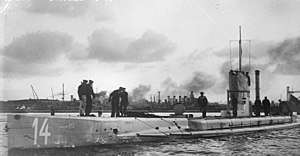Unrestricted submarine warfare

Unrestricted submarine warfare is a type of naval warfare in which submarines sink vessels such as freighters and tankers without warning, as opposed to attacks per prize rules (also known as "cruiser rules"). Prize rules call for submarines to surface and search merchantmen[1] and place crews in "a place of safety" (for which lifeboats did not qualify, except under particular circumstances)[2] before sinking them, unless the ship showed "persistent refusal to stop ... or active resistance to visit or search".[3] The Germans disregarded the law during the First World War following the British introduction of Q-ships with concealed deck guns, and in the most dramatic episode sank Lusitania in 1915 in a few minutes because it was carrying war munitions.[4] The U.S. demanded it stop, and Germany did so. Admiral Henning von Holtzendorff, chief of the Admiralty staff, argued successfully in early 1917 to resume the attacks and thus starve the British. The German high command realized the resumption of unrestricted submarine warfare meant war with the United States but calculated that American mobilization would be too slow to stop a German victory on the Western Front.[5][6]
Following Germany's resumption of unrestricted submarine warfare on February 1, 1917, countries tried to limit or even abolish submarines. Instead, the Declaration of London required submarines to abide by prize rules. These regulations did not prohibit arming merchantmen[7] but having them report contact with submarines (or raiders) made them de facto naval auxiliaries and removed the protection of the prize rules.[8] This rendered the restrictions on submarines effectively useless.[7] While such tactics increase the combat effectiveness of the submarine and improve its chances of survival, some[9] regard them as a breach of the rules of war, especially when employed against neutral vessels in a war zone.
Instances
There have been four major campaigns of unrestricted submarine warfare:
- The U-boat campaign of World War I, waged intermittently by Germany between 1915 and 1918 against Britain and her allies. One of the most famous acts was on May 7, 1915 when U-boat U-20 deliberately torpedoed the British Cunard luxury liner RMS Lusitania. Germany's resumption of unrestricted submarine warfare in February 1917, together with the Zimmermann Telegram, brought the United States into the war on the British side. It was also a casus belli for the entry of Brazil into the war in 1917.
- The Battle of the Atlantic during World War II. Between 1939 and 1945, it was waged between Germany and the Allies and from 1940 to 1943 between Italy and the Allies.
- The Baltic Sea Campaigns on the Eastern Front, during World War II between 1941 and 1945, especially from 1942. Waged by Germany and the USSR against each other, primarily in the Baltic Sea.
- The Pacific War during World War II, between 1941 and 1945, waged by the United States against Japan.
The four cases were attempts to impose a naval blockade on countries, especially those heavily dependent on merchant shipping to supply their war industries and feed their populations (such as Britain and Japan), even though the countries waging the unrestricted submarine warfare were unable to institute a typical naval blockade.
See also
References
- ↑ Holwitt, Joel I. "Execute Against Japan", Ph.D. dissertation, Ohio State University, 2005, pp.5-6.
- ↑ Holwitt, p.92: quoting Article 22 of the London Naval Treaty.
- ↑ Holwitt, p.93.
- ↑ Eardley, Nick (1 May 2014). "Files show confusion over Lusitania". Archived from the original on 30 November 2017 – via www.bbc.co.uk.
- ↑ Dirk Steffen, "The Holtzendorff Memorandum of 22 December 1916 and Germany's Declaration of Unrestricted U-boat Warfare." Journal of Military History 68.1 (2004): 215-224. excerpt Archived 2017-10-22 at the Wayback Machine.
- ↑ See The Holtzendorff Memo (English translation) with notes Archived 2005-03-09 at the Wayback Machine.
- 1 2 Holwitt, p.6.
- ↑ Stockton Naval War College Archived 2017-08-22 at the Wayback Machine., p.324 (retrieved 9 July 2017); Holwitt, pp.76-77; Zabecki, David T. "Doenitz: A Defense", pp.48-49, at Google Books Archived 2018-05-13 at the Wayback Machine. (retrieved 9 July 2017); Dönitz, Karl. Memoirs: Ten Years and Twenty Days; von der Poorten, Edward P. The German Navy in World War II (T. Y. Crowell, 1969); Milner, Marc. North Atlantic Run: the Royal Canadian Navy and the battle for the convoys (Vanwell Publishing, 2006)
- ↑ Holwitt, p.294, for instance. Holwitt, however, persistently refuses to acknowledge armed merchantmen are not protected, and most of the merchantmen sunk by both sides in World War II were armed. See Blair, Silent Victory passim; Parillo, pp.114-115; Zabecki, p.71, at Google Books Archived 2018-05-13 at the Wayback Machine. (retrieved 9 July 2017); Assmann, Kurt. "Why U-Boat Warfare Failed" in Foreign Affairs" Vol. 28, No. 4 (July 1950), pp. 659-670. Available online at jstor.org Archived 2018-05-13 at the Wayback Machine.; Wilson, George Grafton. "Armed Merchant Vessels and Submarines" in The American Journal of International Law, Vol. 24, No. 2 (Apr., 1930), pp. 337-339. Available online at jstor.org Archived 2018-05-13 at the Wayback Machine.;
Sources
- Ronzitti, Natalino (1988). The Law of Naval Warfare: A Collection of Agreements and Documents With Commentaries. Martinus Nijhoff. ISBN 978-90-247-3652-2.
- Willmott, H. P. (2003). World War I. Dorling Kindersley. ISBN 978-0-7894-9627-0.